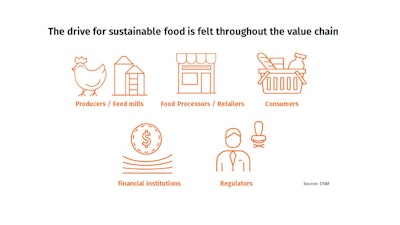
Multiple drivers underpin the global target to achieve net zero greenhouse gas (GHG) emissions by 2050. Many of these are regulatory, but more and more are organizations and individuals’ voluntary choices.
The global poultry sector is being reshaped by fast-evolving societal issues and changing consumption patterns. Both the shift away from antibiotic use in the U.S., for example, and the move to slower growing broilers in parts of Europe are a result of societal concerns related to antimicrobial resistance (AMR) and animal welfare.
Many producers have shown that commercial success is possible with No Antibiotics Ever or Antibiotic-Free feeding systems. Fortunately, AMR is reversible if the industry adopts a holistic approach to health, management, biosecurity and nutrition.
However, the production of slower-growing birds for animal welfare motives may run counter to the drive to reduce the industry’s environmental footprint. Achieving an effective balance between these two objectives will require novel approaches from producers.
Pressure for change
Measured against the international treaty on climate change, the Paris Agreement, targets, current livestock production is already transgressing planetary boundaries, and fundamental change is required on many fronts.
The drive for sustainable food is manifesting itself throughout the value chain, with a strong push coming from investors, retailers and consumers.
Financial institutions, for example, are looking to develop net zero loan portfolios; food retailers are making science-based commitments to reduce their emissions and those of the products they retail; and consumers, concerned about their own environmental impact, want to know more about the products they buy.
All these factors compel poultry producers and feed millers to reduce their environmental footprints – before regulatory requirements are factored into the mix.
Positive trends
Sixty to 70% of consumers today claim to support the carbon-labelling of food, while 30% are said to be willing to pay more for foods that are more sustainable than their conventional equivalents.
Eco-labels are helping them to make more informed choices, and products marketed based on sustainability are unlocking significant market value. In the U.S., for example, sustainability-positioned products account for 16% of the consumer-packaged goods (CPG) market and enjoy a price premium of 39% over conventionally marketed products, according to the New York University Stern Center for Sustainable Business.
Retailers and CPG companies, meanwhile, are increasingly exploring carbon-abatement strategies with their suppliers – not surprisingly, given that 80% of the total carbon footprint for many companies is attributable to their GHG Protocol Scope 3 emissions from the upstream supply chain, principally the farm.
Our industry is, therefore, having to provide credible metrics and proof of its sustainable practices, ranging from the raw materials used in feed through to management of manure on farms.
Reliable data – for the entire value chain
To meet these requirements, our industry will have to make demonstrable reductions across the board, in terms of emissions, energy use, land use, water use, food loss and waste.
Having a clear understanding of the farm's environmental footprint is a good business diagnostic: a large footprint is often associated with inefficiency.
Satisfying the information needs of the various stakeholders means an accurate, credible picture of poultry farms’ environmental footprint is needed. Reliable data shared throughout the value chain will therefore be the key to more sustainable poultry production going forward.

















